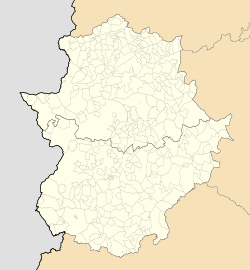Olivença, Portugal
|
Olivenza Olivenza (Spanish) Olivença (Portuguese) |
|||
|---|---|---|---|

Castle of Olivenza/Olivença
|
|||
|
|||
 Location of the Olivenza/Olivença territory in the Portuguese-Spanish border |
|||
| Location of Olivenza within disputed area of Spain/Portugal | |||
| Coordinates: 38°41′9″N 7°6′3″W / 38.68583°N 7.10083°WCoordinates: 38°41′9″N 7°6′3″W / 38.68583°N 7.10083°W | |||
| Country | Disputed: | ||
| Status within Spain | Extremadura | ||
| Status within Portugal | Alto Alentejo Province | ||
| Government | |||
| • Mayor | Manuel José González Andrade (PSOE) | ||
| Area | |||
| • Total | 750 km2 (290 sq mi) | ||
| Elevation | 327 m (1,073 ft) | ||
| Population (2005) | |||
| • Total | 11,512 | ||
| • Density | 27/km2 (70/sq mi) | ||
| Time zone | CET (UTC+1) | ||
| • Summer (DST) | CEST (UTC+2) | ||
| Postal code | 06100 | ||
| Website | Town Hall (in Spanish) | ||
Olivenza (Spanish: [oliˈβenθa]) or Olivença (Portuguese: [oliˈvẽsɐ]) is a town situated on a disputed section of the Portugal–Spain border. It is administered de facto by Spain, as part of the autonomous community of Extremadura. Portugal holds a claim on the town and its surrounding territory.
As Olivença, the town was under Portuguese sovereignty between 1297 (Treaty of Alcañices) and 1801 when it was invaded by the Spanish during the War of the Oranges and then ceded to Spain under the Treaty of Badajoz. Spain has since administered the territory (now split into two municipalities, Olivenza and Táliga), whilst Portugal invokes the self-revocation of the Treaty of Badajoz, plus the Treaty of Vienna of 1815, to claim the return of the territory. In spite of the territorial dispute between Portugal and Spain, the issue has not been a sensitive matter in the relations between these two countries. Olivenza and other neighbouring Spanish (La Codosera, Alburquerque and Badajoz) and Portuguese (Arronches, Campo Maior, Estremoz, Portalegre and Elvas) towns reached an agreement in 2008 to create a euroregion.
...
Wikipedia



